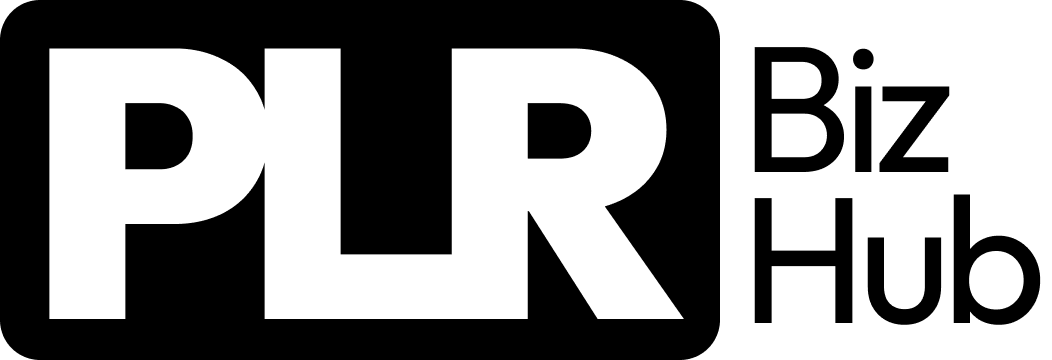Most people think customization means simply changing colors or adding their logo. But successful PLR resellers know that effective customization goes much deeper, transforming generic content into products that solve specific problems for targeted audiences.
Key Takeaways
How to effectively customize PLR templates for your brand:
- Brand integration: Replace all generic elements with your brand colors, fonts, logos, and messaging to create consistent visual identity across all templates
- Content personalization: Modify text, examples, and case studies to reflect your expertise and speak directly to your target audience’s pain points
- Visual enhancement: Upgrade graphics, images, and design elements to match current design trends and your brand aesthetic
- Value addition: Include bonus materials, worksheets, or exclusive content that competitors using the same PLR won’t have
- Format optimization: Adapt templates for multiple platforms and devices to maximize usability and customer satisfaction
- Niche targeting: Customize language, examples, and features to serve specific market segments rather than trying to appeal to everyone
Ready to skip the time-consuming customization process entirely? PLR Digital Products on plrbizhub.com offers professionally customized templates that are ready to sell immediately. These aren’t your typical generic PLR files – they’re fully customized, brand-ready digital products that help you launch your business today.
Brand Alignment Strategies
Understanding Your Brand Identity
Before diving into template customization, you need crystal-clear brand guidelines. Your brand identity encompasses more than just visual elements – it includes your voice, values, and the unique perspective you bring to your niche.
Start by defining your brand’s core elements:
- Color palette: Choose 3-5 colors that represent your brand personality
- Typography: Select 2-3 fonts that work harmoniously together
- Voice and tone: Determine whether your brand is professional, casual, inspirational, or educational
- Visual style: Decide if your aesthetic is minimalist, bold, vintage, or modern
Implementing Consistent Visual Elements
Color scheme transformation is your first customization priority. Generic PLR templates often use placeholder colors that don’t resonate with any specific brand. Replace these with your signature colors throughout every element – headers, backgrounds, accent colors, and call-to-action buttons.
Typography consistency creates instant brand recognition. Most PLR templates use common fonts like Arial or Times New Roman. Elevate your templates by implementing your brand fonts consistently across headlines, body text, and decorative elements.
Logo and branding elements should appear strategically without overwhelming the content. Place your logo in headers, footers, and key pages, but avoid cluttering every page with branding that distracts from the main content.
Useful Articles:
Content Personalization Techniques
Tailoring Text and Messaging
Generic PLR content speaks to everyone and connects with no one. Effective customization means rewriting content to speak directly to your ideal customer’s specific situation, challenges, and goals.
Language adaptation involves changing the tone and terminology to match how your audience communicates. If you’re targeting busy moms, use conversational language with relatable examples. For corporate professionals, adopt more formal language with industry-specific terminology.
Example replacement transforms abstract concepts into concrete, relatable scenarios. Instead of generic examples like “imagine you want to lose weight,” use specific examples like “picture yourself confidently wearing that dress to your high school reunion.”
Personal story integration adds authenticity that generic PLR lacks. Weave in your own experiences, client success stories, or case studies that demonstrate your expertise and build trust with potential customers.
Adding Your Unique Perspective
Expert insights differentiate your customized templates from identical competitors. Add your professional commentary, tips learned through experience, and unique strategies that reflect your expertise in the field.
Current information updates ensure your templates remain relevant and valuable. Replace outdated statistics, examples, and references with current data and trends in your industry.
Design Enhancement Methods
Visual Upgrade Strategies
Image replacement dramatically impacts template appeal. Stock photos in original PLR templates are often overused and generic. Replace them with higher-quality images that align with your brand aesthetic and target audience demographics.
Layout improvements can transform cluttered, outdated designs into modern, user-friendly templates. Increase white space, improve readability with better text hierarchy, and ensure mobile-responsive design elements.
Interactive elements add value that static templates can’t provide. Include clickable table of contents, fillable form fields, bookmarks, and hyperlinked resources that enhance user experience.
Professional Design Touches
Consistent spacing and alignment creates polished, professional appearance. Ensure headers, paragraphs, and design elements follow consistent spacing rules throughout the entire template.
Color psychology application uses colors strategically to evoke desired emotions and actions. Blue conveys trust and professionalism, green suggests growth and money, while red creates urgency and excitement.
Typography hierarchy guides readers through content logically. Use different font sizes, weights, and styles to create clear distinction between headlines, subheadings, and body text.
Useful Articles:
Platform Optimization Strategies
Multi-Platform Customization
Platform-specific requirements vary significantly across selling platforms. Etsy customers prefer certain design aesthetics, while corporate clients on platforms like Gumroad expect more professional layouts.
File format optimization ensures compatibility across devices and platforms. Create templates in multiple formats – PDF for universal access, PowerPoint for easy editing, and Canva templates for user customization.
Mobile responsiveness has become essential as more customers access digital products on mobile devices. Test your templates on various screen sizes and adjust layouts accordingly.
Marketplace Compliance
Platform guidelines adherence prevents account suspensions and ensures your products remain visible in search results. Each marketplace has specific requirements for image dimensions, file sizes, and content restrictions.
Copyright compliance protects your business from legal issues. Remove any copyrighted images, fonts, or content from original PLR templates and replace with properly licensed alternatives.
Value-Added Customization
Bonus Content Creation
Supplementary materials increase perceived value and justify higher prices. Add bonus worksheets, checklists, resource lists, or quick-reference guides that complement the main template content.
Exclusive insights that aren’t available in the original PLR make your version unique. Include personal tips, advanced strategies, or insider knowledge that reflects your expertise and experience.
Community access or follow-up resources create ongoing value beyond the initial purchase. Offer buyers access to private Facebook groups, email courses, or video tutorials that support template implementation.
Interactive Features
Fillable forms and worksheets transform static content into actionable tools. Use PDF form fields, interactive checkboxes, and fillable text areas that customers can complete digitally.
Clickable navigation improves user experience in longer templates. Add bookmarks, table of contents links, and cross-references that help users quickly find relevant information.
Multimedia integration enhances learning and engagement. Include QR codes linking to video tutorials, audio recordings, or online resources that support the template content.
Useful Articles:
Niche-Specific Customization
Target Audience Adaptation
Demographic customization ensures templates resonate with specific audience segments. Templates for millennials need different design aesthetics and language than those targeting baby boomers or Gen Z customers.
Industry-specific modifications make generic business templates relevant for particular sectors. A marketing template for restaurants needs different examples and strategies than one designed for fitness coaches.
Skill level adjustments accommodate different experience levels within your niche. Beginner-friendly templates need more explanation and step-by-step guidance, while advanced users prefer condensed, action-oriented content.
Cultural and Regional Considerations
Language localization goes beyond translation to include cultural context, idioms, and communication styles that resonate with specific geographic markets.
Currency and measurement conversions make templates immediately usable for international audiences without requiring customers to do conversions themselves.
Legal and regulatory compliance ensures templates meet local requirements for business practices, privacy policies, and industry regulations in your target markets.
Technical Customization Tips
Software and Tools
Design software proficiency accelerates customization process. Master tools like Canva Pro, Adobe Creative Suite, or Figma to efficiently modify templates while maintaining professional quality.
Template editors vary in capability and ease of use. PowerPoint and Google Slides work well for basic customizations, while Adobe InDesign offers advanced layout control for complex templates.
Batch processing techniques save time when customizing multiple templates. Create brand guideline templates and use find-and-replace functions to update colors, fonts, and branding across entire template collections.
Quality Control Processes
Proofreading and editing ensures professional presentation. Check for spelling errors, grammar mistakes, and formatting inconsistencies that could damage your brand reputation.
Functionality testing verifies that all interactive elements work properly across different devices and software versions before releasing products to customers.
Customer feedback integration from beta testers or early customers helps identify improvement opportunities and common usability issues.
Advanced Customization Strategies
Data-Driven Improvements
Analytics integration helps track which customizations perform best with your audience. Use tools like Google Analytics or platform-specific metrics to understand customer behavior and preferences.
A/B testing variations of customized templates reveal which design elements, colors, and content structures generate higher conversion rates and customer satisfaction.
Competitor analysis identifies customization opportunities by examining what successful sellers in your niche are doing differently with similar PLR templates.
Scalable Customization Systems
Template libraries organized by customization level allow you to efficiently manage multiple product variations for different market segments.
Standardized processes ensure consistent quality across all customized templates while reducing time investment per product.
Outsourcing strategies for technical customizations let you focus on high-value activities like content creation and marketing while delegating design work to specialists.
Monetization Through Customization
Pricing Strategies
Value-based pricing for heavily customized templates can command significantly higher prices than minimally modified PLR products. Customers pay premium prices for products that solve specific problems effectively.
Tiered offerings allow you to sell the same base template at different price points based on customization level – basic, professional, and premium versions with increasing levels of personalization.
Bundle opportunities combine multiple customized templates into themed collections that provide comprehensive solutions for specific customer needs.
Market Positioning
Unique selling propositions emerge from thoughtful customization that addresses gaps in the current market. Position your templates as solutions that competitors haven’t thought to create.
Expert positioning comes naturally when your customizations demonstrate deep understanding of your niche and customer pain points.
Brand recognition develops as customers associate your distinctive customization style with quality and value, leading to repeat purchases and word-of-mouth marketing.
Transform generic PLR templates into profit-generating digital products by mastering how to customize PLR templates for reselling. With strategic customization, consistent branding, and value-added enhancements, you’ll create unique products that customers choose over identical competitors, building a sustainable digital product business that generates consistent revenue.




